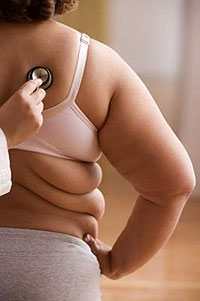Body Fat and Women
 Women tend to have more body fat than men—about five percent more. By nature, a woman's body is developed to protect her and a potential fetus. As a result, women have more enzymes for storing fat and fewer enzymes for burning fat. Additionally, the estrogen women have activates fat storing enzymes and causes them to multiply. Women tend to have more body fat than men—about five percent more. By nature, a woman's body is developed to protect her and a potential fetus. As a result, women have more enzymes for storing fat and fewer enzymes for burning fat. Additionally, the estrogen women have activates fat storing enzymes and causes them to multiply.
The minimum percent bodyfat considered safe for good health is 12% for females. The average adult body fat is closer to 22%-25% for women. Athletes tend to be at low end of this scale due to the increased lean weight (muscle mass) of top athletes. While low levels of bodyfat seem to be related to improved performance, body composition alone is not a great predictor of sports success. A linebacker needs to have enough body mass (lean and fat weight) to generate high forces and avoid injury. Bodyfat among elite athletes vary largely by sport. There is little evidence benefit when women drop under 14% bodyfat. Women athletes who lose too much fat risk injury, decreased performance and health issues. Just as too little body fat can cause physiological complications, too much body fat is also harmful. For women over 32% fat, there is a dramatic correlation with illness and disease. Obesity has become a serious health threat for women at every stage of life. Body Type | Female |
|---|
Athlete | <17% | Lean | 17-22% | Normal | 22-25% | Above Average | 25-29% | Overfat | 29-35% | Obese | 35+% |
How to determine body fat percentage?  There are several ways to find out your body fat percentage. Unfortunately, the more accurate the method, the more of a hassle and/or expensive it tends to be. There are several ways to find out your body fat percentage. Unfortunately, the more accurate the method, the more of a hassle and/or expensive it tends to be.
DEXA scan – full body X-ray scan of the same type used for bone density. Very accurate.
Hydrostatic Weighing – Weighing under water (completely submerged, with all air blown out of lungs) – Very accurate when done professionally.
Skin-fold calipers (“pinch test”) – Simple, but needs to be done by someone who is trained, and you can’t do it on yourself. Wide variations in accuracy for people without training.
Bioelectrical Impedance (BIA) – These are scales and hand-held devises that run low-level (and painless) electrical current through you. They can be accurate, although the accuracy varies according to the specific device and how it is used. Best results are obtained first thing in the morning with no alcohol consumed for 2 days prior, and no exercise the night before.
 Navy tape measure method - This is a formula based on several body measurements taken with a tape measure. It can be quite accurate (it is used by the military), but it does depend upon your ability to accurately measure. Using centimeters rather than inches is the best, but using inches within ¼ of an inch works. To be sure, measure yourself 3 times and take the average. It is especially useful for tracking yourself over time. Navy tape measure method - This is a formula based on several body measurements taken with a tape measure. It can be quite accurate (it is used by the military), but it does depend upon your ability to accurately measure. Using centimeters rather than inches is the best, but using inches within ¼ of an inch works. To be sure, measure yourself 3 times and take the average. It is especially useful for tracking yourself over time.
Managing body fat Each living cell of the body requires energy to survive. Losing muscle mass or possessing low muscle composition causes fat-burning fires to die down much more rapidly, compared with getting older or losing fitness.
|

 There are several ways to find out your body fat percentage. Unfortunately, the more accurate the method, the more of a hassle and/or expensive it tends to be.
There are several ways to find out your body fat percentage. Unfortunately, the more accurate the method, the more of a hassle and/or expensive it tends to be. Navy tape measure method - This is a formula based on several body measurements taken with a tape measure. It can be quite accurate (it is used by the military), but it does depend upon your ability to accurately measure. Using centimeters rather than inches is the best, but using inches within ¼ of an inch works. To be sure, measure yourself 3 times and take the average. It is especially useful for tracking yourself over time.
Navy tape measure method - This is a formula based on several body measurements taken with a tape measure. It can be quite accurate (it is used by the military), but it does depend upon your ability to accurately measure. Using centimeters rather than inches is the best, but using inches within ¼ of an inch works. To be sure, measure yourself 3 times and take the average. It is especially useful for tracking yourself over time.





No comments:
Post a Comment